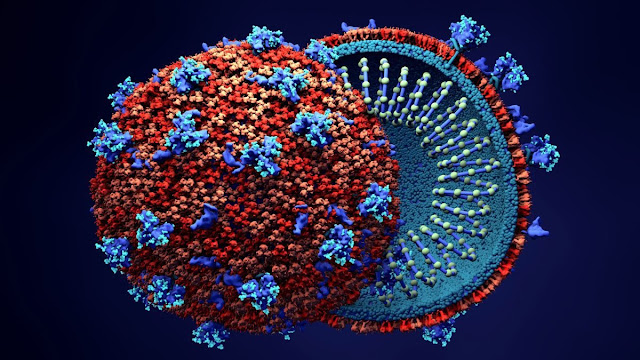Viruses. Undead pathogens: the borrower and destroyer of life.
Is there a reason for a virus to exist? And if so, what is its purpose? They are by the definition an evolutionary microscopic compound of internal DNA and RNA (ribonucleic acid), that, without a living host to infect - are more or less an inactive 'dead' entity. But these are the questions that virologists and biologists have asked for over a hundred years of studying the impact that virus have had on living organisms, including plant life, have at one time or another classified viruses as either a mutant by product of nature or an non living chemical compound. In more recent years, evolutionary biologists and the new science of studying the complexity of bacteria, to which a virus has a unique symbiotic relationship with, in fact, the argument posed is that the evolution of bacteria was crucial for it to be infected with a viral DNA. Once a bacteria living cell structure is infected by a virus, the viral intruder quickly replicates itself while inserting newer DNA into their bacterium hosts – which as a classification of a living organism, are able to generate energy and create molecules to sustain itself.
Some scientists have further hypothesized that Viruses were not only necessary to all aspects of evolution, but also hold a key in the process of evolving or filtering the weak from the strong within the terminology of survival of the fittest. With theories that viruses are able to rework our own DNA, while overtime changing the physiological characteristics. These are controversial statements, but before we delve into the moral grounds of what a virus is and what it isn't, we first have to look at its discovery and origins.
In 1886 Adolf Mayer a German agricultural chemist was asked by Dutch farmers to investigate the discoloration and eventual destruction of tobacco leaves, his research found that rather than a toxin or small bacteria being the culprit. He analyzed that the sap from the branches of the plant was the reason, yet, the idea of a nano-size organism being the prelude to the infection was still eluding.
With telescopic science still evolving, it was thought that bacteria, which is larger than a viral compound, was still the reason, it was not until Martinus Beijerinck in 1898 a Dutch microbiologist, who studied the filtration process of detaching the bacterial infection from the host plant. Was unable to find that through a filtration process a removal of the bacterial compounds, the infection remained within the plant leaves. This in turn, defined Beijerinck's reasoning that a more virulent and smaller organism is at work – he coined the term 'Virus' in explaining this microscopic abnormality and its ability to replicate. Beijerinck helped in the field of biochemistry characterizing the difference between bacteria and viruses as two separate pathogens, to which Beijerinck was one the founders of what know as modern day Virology.
With telescopic science still evolving, it was thought that bacteria, which is larger than a viral compound, was still the reason, it was not until Martinus Beijerinck in 1898 a Dutch microbiologist, who studied the filtration process of detaching the bacterial infection from the host plant. Was unable to find that through a filtration process a removal of the bacterial compounds, the infection remained within the plant leaves. This in turn, defined Beijerinck's reasoning that a more virulent and smaller organism is at work – he coined the term 'Virus' in explaining this microscopic abnormality and its ability to replicate. Beijerinck helped in the field of biochemistry characterizing the difference between bacteria and viruses as two separate pathogens, to which Beijerinck was one the founders of what know as modern day Virology.
However it was the chemist Wendell M Stanley in 1935 who studied the Tobacco virus, also known as the TMV (tobacco mosaic virus) due to it mosaic discoloration and pattern, in a chemical process of crystallizing the virus. Stanley saw that it remained active after the process of being in a fluid state to a crystalline stage. From his research on the TMV, he released a scientific paper, which awarded him a shared Nobel Price in 1946. His explanation is that a Virus is devoid of any metabolic functions, in other words it does not have the biochemistry that would consider it to be a living organism.
Except, despite a virus not being a living organism as such, rather just a primitive entity that harbors underneath its sheath of protein its own DNA and the more unstable RNA coding, which in turn needs to infect a living host to insert and duplicate its foreign DNA into the metabolic organism. A virus doesn't create, yes it may alter physiological aspects of the living cell, yet as the science of studying these viral invaders meliorates, various researchers have decreed that a virus for it to exist “borrowers” life from the host. But without an ability to exsist as a lifeform, it becomes one of the greatest destroyers of life.
The ultimate question/s is asked. Should, once a virus has been decoded and a vaccine sourced: therefor be wiped out? Removed from the evolutionary scale. A dilemma that virologists have in regards to what a viruses purpose actually is, other than its scourge to humanity. To whether or not they should be completely eradicated rather than studied. This stands as both a moral an scientific viewpoint. On the notion that viruses from our history, despite the suffering and death a pandemic brings, may be of a natural evolutionary process; should be continually studied in the laboratory.
And he lies the danger of losing control, through over experimentation within a lab setting of extinct and so called managed viruses – when no virus DNA is alike and dangerously prone to mutation, by human error it may evolving into a devastating microscopic killing machine.


Comments
Post a Comment